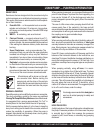
PAGE 38 — MAYCO LS600 PUMP — OPERATION AND PARTS MANUAL — REV. #4 (9/15/11)
LS600 PUMP — MAINTENANCE (PUMP)
Wear
safety glasses
or
face mask
,
protective clothes, and rubber gloves when
working with battery.
CAUTION - BATTERY MAINTENANCE SAFETY
BATTERY MAINTENANCE
Mishandling of the battery shortens the service life of the
battery and adds to maintenance cost. When handling the
battery do the following:
Be careful not to let the battery electrolyte come in
contact with your body or clothing.
Always wear
eye protection
and
rubber gloves
, since
the battery contains sulfuric acid which burns skin and
eats through clothing.
Always check the battery terminals periodically to
ensure that they are in good condition.
Use wire brush or sand paper to clean the battery
terminals.
Always check battery for cracks or any other damage.
If white pattern appears inside the battery or paste has
accumulated at the bottom, replace the battery.
If the pump will not be in operation for a long period of
time, store in cool dry place and check the battery
charge level every month to maintain the performance
of the battery.
Check the battery regularly and make sure that each
electrolyte level is to the bottom of the vent well
(Figure 39). If necessary add only distilled water in a
well-ventilated area.
Figure 39. Battery Electrolyte Levels
BRAKE SYSTEM
The brake system should be periodically checked. Look
for fluid leaks worn or cracked hoses. Check the reservoir
for proper fluid levels. The Atwood surge brake should be
checked for damage. Make sure that all links and pivots
are kept lubricated.
1. Keep all links and pivots lubricated to prevent rusting
and ensure ease of operation. Using SAE 30 oil, lubricate
inside the release handle and inside the actuator body.
This can be reached from the underside of the actuator.
Lubricate the hitch ball with conventional
automotive grease or a lubricant made for
hitch balls.
2. Check for any leaks in the brake system. Periodic
checks should be made on all hoses to guard against
cuts and worn hoses which may cause failure (leaks,
rupturing under pressure, and collapsing). Replace
defective hoses.
DO NOT fill the master cylinder reservoir with used
brake fluid. DO NOT fill the reservoir beyond ½" from
top. DO NOT overfill; brake fluid will damage paint.
CAUTION - MASTER BRAKE CYLINDER
3. Check the brake fluid level in the master cylinder
reservoir. Keep it filled to within ½" from the top of the
reservoir.
4. At the beginning of each year, inspect the brakes for
excessive wear, replace the linings if necessary.
Wheel bearings and seals should be
inspected and packed at this time.


















